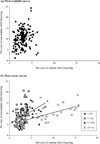The relationship between orphanhood and child fostering in sub-Saharan Africa, 1990s-2000s
- PMID: 22607126
- PMCID: PMC3473157
- DOI: 10.1080/00324728.2012.681682
The relationship between orphanhood and child fostering in sub-Saharan Africa, 1990s-2000s
Abstract
In countries most afflicted by HIV/AIDS in sub-Saharan Africa, orphanhood has increased dramatically, but the potential consequences of the increase have been mitigated by the ability of households to absorb orphans. This paper examines what the rising levels of orphanhood mean for the common practice of non-orphan child fostering in regions of high and low HIV prevalence in sub-Saharan Africa, which has a long history of child fostering. Using Demographic and Health Survey data from 135 regions within 14 sub-Saharan countries that undertake HIV testing and have had at least two surveys, we examine changes in fostering patterns. In most regions, we find a more accommodating relationship between orphan and non-orphan fostering: communities are able to absorb the demand for both orphans and non-orphans. Where HIV prevalence exceeds 10 per cent there is some evidence that the need to care for orphans is beginning to reduce opportunities for non-orphan fostering.
Figures




Similar articles
-
Orphanhood and childcare patterns in sub-Saharan Africa: an analysis of national surveys from 40 countries.AIDS. 2004 Jun;18 Suppl 2:S55-65. doi: 10.1097/00002030-200406002-00007. AIDS. 2004. PMID: 15319744
-
Epidemiology of health and vulnerability among children orphaned and made vulnerable by HIV/AIDS in sub-Saharan Africa.AIDS Care. 2006 Apr;18(3):269-76. doi: 10.1080/09540120500471861. AIDS Care. 2006. PMID: 16546789
-
Dimensions of the emerging orphan crisis in sub-Saharan Africa.Soc Sci Med. 2003 Mar;56(6):1235-47. doi: 10.1016/s0277-9536(02)00125-9. Soc Sci Med. 2003. PMID: 12600361
-
HIV Orphanhood Research and the Representation of Older Orphans in Sub-Saharan Africa: A Literature Review.J Assoc Nurses AIDS Care. 2016 Jan-Feb;27(1):57-65. doi: 10.1016/j.jana.2015.09.002. Epub 2015 Sep 15. J Assoc Nurses AIDS Care. 2016. PMID: 26482073 Review.
-
Orphans and Vulnerable Children Affected by Human Immunodeficiency Virus in Sub-Saharan Africa.Pediatr Clin North Am. 2016 Feb;63(1):131-47. doi: 10.1016/j.pcl.2015.08.007. Pediatr Clin North Am. 2016. PMID: 26613693 Review.
Cited by
-
The impact of family transitions on child fostering in rural Malawi.Demography. 2014 Feb;51(1):205-28. doi: 10.1007/s13524-013-0239-8. Demography. 2014. PMID: 24019099 Free PMC article.
-
Early deprivation alters structural brain development from middle childhood to adolescence.Sci Adv. 2022 Oct 7;8(40):eabn4316. doi: 10.1126/sciadv.abn4316. Epub 2022 Oct 7. Sci Adv. 2022. PMID: 36206331 Free PMC article. Clinical Trial.
-
Children Living with HIV-Infected Adults: Estimates for 23 Countries in sub-Saharan Africa.PLoS One. 2015 Nov 17;10(11):e0142580. doi: 10.1371/journal.pone.0142580. eCollection 2015. PLoS One. 2015. PMID: 26575484 Free PMC article.
-
Resolving unintended pregnancy crisis: Is adoption a viable option? A cross-sectional study in Kumasi, Ghana.SAGE Open Med. 2020 Sep 18;8:2050312120959181. doi: 10.1177/2050312120959181. eCollection 2020. SAGE Open Med. 2020. PMID: 32999722 Free PMC article.
-
Anticipatory child fostering and household economic security in Malawi.Demogr Res. 2014 Apr 10;30:1157-1188. doi: 10.4054/DemRes.2014.30.40. Demogr Res. 2014. PMID: 25419172 Free PMC article.
References
-
- Akresh Richard. Flexibility of household structure child fostering decisions in Burkina Faso. Journal of Human Resources. 2009;44(4):976–997.
-
- Ainsworth Martha, Beegle Kathleen, Koda Godlike. The impact of adult mortality and parental deaths on primary schooling in north-western Tanzania. Journal of Development Studies. 2005;41(3):412–439.
-
- Alber Erdmute. Grandparents as foster-parents: Transformations in foster relations between grandparents and grandchildren in northern Benin. Africa. 2004;74(1):28–46.
-
- Ankrah E. Maxine. The impact of HIV/AIDS on the family and other significant relationships: the African clan revisited. AIDS Care. 1993;5(1):5–22. - PubMed
-
- Ansell Nicola, van Blerk Lorraine. Children’s migration as a household/family strategy: Coping with AIDS in Lesotho and Malawi. Journal of Southern African Studies. 2004;30(3):673–690.
Publication types
MeSH terms
Grants and funding
LinkOut - more resources
Full Text Sources
Medical
